Donation request letters and forms are crucial tools used by organizations to seek financial or in-kind support from individuals, businesses, and philanthropic entities. These documents convey a compelling need,…
continue reading
38+ Sample Return to Work Forms
-

Return to Work Status Form
download now -

Employee Return to Work Form
download now -

Workers Compensation Return to Work Form
download now -

Ability and Return to Work Form
download now -

Return to Work Authorization Form Template
download now -

Return to Work Authorization form
download now -

Return-to-Work Form amd Report
download now -

Return to Work Interview Form
download now -

Return to Work Form Format
download now -

Fitness To Work Assessment Form
download now -

Employee Return to Work Certification Form
download now -
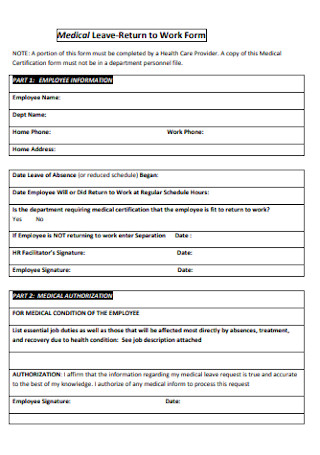
Medical Leave Return to Work Form
download now -

Maternity Release to Return to Work Form
download now -

Return to Work Release Form
download now -

Self Certification and Return to Work Interview Form
download now -

Return to Work Medical Certification Form
download now -

Employee Return to Work Exception Form
download now -

Release to Return to Work Form
download now -

Return to Work Evaluation Form
download now -

Physician Return to Work Form
download now -

Sample Return to Work Form
download now -
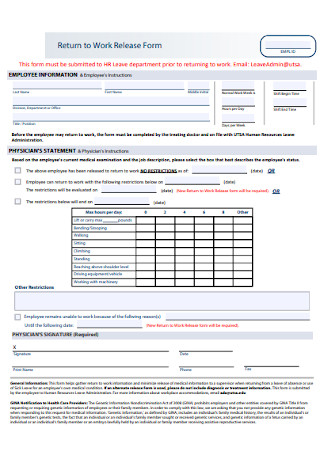
Sample Return to Work Release Form
download now -

Basic Return to Work Form
download now -
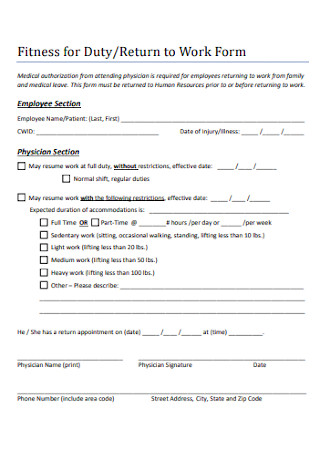
Fitness for Duty and Return to Work Form
download now -

Return to Work Certification Form
download now -
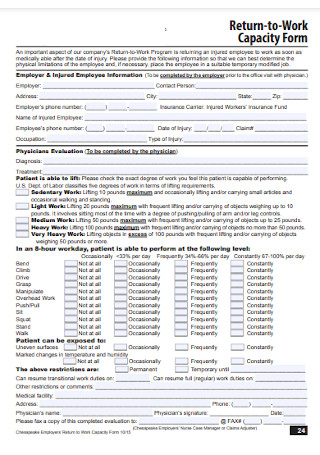
Return-to-Work Capacity Form
download now -

Return to Work Restrictions Form
download now -
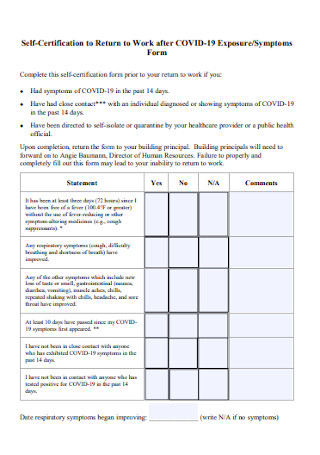
Self-Certification to Return to Work Form
download now -

Stay At or Return to Work Form
download now -

Silk Leave Return to Work Form
download now -

Return to Work Evaluation Form Template
download now -

Self-Certification and Return to Work Form
download now -

Standard Return to Work Form
download now -

Return to Work Declaration Form for Employees
download now -

Return to Work Discussion Form
download now -

Volunteer Return to Work Form
download now -

Medical Release to Return to Work Form
download now -

Sample Pre-return to Work Form
download now -

Confidental Return to Work Form
download now
What Is Return To Work Forms?
Return to Work Forms is a sample fit-for-duty form that employees need to fill out. The form and interview should talk about the reason of the absence. It is also to check if the staff member is doing well enough to return to work. In addition, it can be used to update them about anything they may have missed while they were not in the office.
Why Should You Use a Return To Work Form?
After sickness or vacation, completing a return to work form gives a bigger understand of the reasons employees are off work, and to identify if there are any patterns in their absences. It also helps in reducing absenteeism as these staff members are less likely to give bad excuses or made-up reasons for their absences. Take note that the interview and return to work assessment form are to support employees as well. They should feel like you are assisting them and not judging or investigating their absence. While there is no regulation demanding workers to fill out a return to work form, you may decide to make it a requirement at your will. In this case, you should include concrete details within employee contracts and your official handbook.
What Is Included In a Fit To Return To Work Form?
Inside this form, employees will find questions concerning their absence like the duration of absence; the process used to record absence; the reason for absence; General Practitioner recommendations (if there are any) and; request for reasonable adjustments (if applicable).
Afterwards, both parties should sign the return to work form agreeing to any action or reasonable adjustments that are essential.
What Is The Importance Of Creating An Interview Template For Return To Work?
Maintaining a procedure that addresses employees who are returning to work lets you manage absences efficiently and consistently. An absence management policy should be in line with the guidelines from the company or organization and must apply to all employees with a contract of employment. If you are struggling to make an original form, you can find various return to work form templates at the above section that you can then use for your company.
4 Steps To a Successful Return To Work
It may be vital to work separately with each affected employee, however, these steps are good starting points for an organization’s return to work program:
FAQs
Due to Covid19 pandemic, what does an employer need to do to make sure the workplace is safe for return to work?
Employers have been expected to do what is rational and obligatory to reduce the transmission of Covid-19 and to achieve this throughout the pandemic. The companies must take on a risk assessment of the workplace to classify the risks and make the necessary actions to remove the risk. They should also ensure that ventilation is considered within the risk assessment as the medical advisors stressed the importance of airflow to lessen the transmission of the known virus. For instance, if windows need to be kept open to provide more ventilation, this should be balanced with suitable working temperatures. Employers may also take action to control the potential spread of the virus by adopting reasonable measures and implement policies like frequent cleaning or office disinfection; hand sanitation; ensure that anyone who is not doing well does not come to the workplace and follows the rules on self-isolation and; social distancing and wearing of facemasks. Employers must have attention to equality law to consider those who are medically excused from wearing a mask.
Can employers force employees to return to work?
Employers can request that employees return to the workplace since the requirement to work from home has been lifted. However, most governments suggest that the public should just act ‘slowly’ to the easing of restrictions as it may be more suitable to consider hybrid working methods or a gradual return to the workplace. An employee may be able to refuse to return to the office if they have concerns about health and safety checklist. The law will protect an employee from detriment if they rationally believe that going to work would put them in serious and impending danger. It must be taken seriously if an employee raises concerns over health and safety issues. An employer may need to assure an employee of the measures put in place or re-evaluate whether further action needs to be taken to ensure safety in the workplace. Moreover, an employee may also raise concerns related to their own health condition or for another personal reason which will require to be cautiously considered. The employer has a duty to make reasonable adjustments if the employee is disabled. However, if an employee keeps on refusing to go back to work despite proper measures in place, the employer could decide a disciplinary proceeding. It would be advisable to seek legal advice before taking this action.
What happens when you have one or more employees who are temporarily incapable to perform the lifting, standing or driving tasks required in their positions?
Since companies or employers cannot speed up the healing process and are worried that these statistics may hold true for your employees, this may be the proper actions to take:
- If a worker is off for up to three weeks, there is at least 75 percent chance of returning to work.
- If a worker is off for six weeks, there is at least 50 percent chance of returning to work.
- If a worker is off a year, there is only a 1 percent chance of returning to work. Making employees get back on the job as soon as possible saves companies some money.
Employers will save on the direct costs associated with claims, which may also lower insurance costs. They will also avoid other expenses from indirect costs—such as lost productivity, overtime, and hiring and training replacement workers.
Is there a return to work-program?
There are a lot of ways to save money, retain workers, and keep these employees happier and more dedicated to your organization. A return to work program affluences employees back into the job after an illness or injury. In reality, organizations with a return to work program are more likely to return injured employees than organizations without a program. This type of program offers transitional work (recommended by a medical personnel) while an employee gains recovery from a work-related injury or illness. The employee may be presented modified work or alternative work. An employee who is assigned to modified work will continue to work the regular job with some restrictions. This may mean changing a part of the employee’s job, such as reducing the number of hours the employee works or cutting back on lifting or standing for long periods of time. Other examples include modifying the workstation or removing parts of the job that the employee is incapable to perform. On the other hand, if an employee is not capable to do the regular tasks, the organization offers a different temporary position that meets the work restrictions.
Is there any helpful approach to minimize the stress and adapt quickly for the transition back to the office?
There are few helpful approach to minimize the stress and adapt quickly for the transition back to the office like:
Monitor your anxiety. You may feel tended to hide your anxiety about coming back to work, pretending confidence and positivity in the face of so much unknown. On the other hand, you may be oblivious of the extent to which you are wearing your anxiety on your sleeve. Pay close attention to whatever degree you feel concerned about returning to work—regardless of your inclination to hide or broadcast it. Most significantly, find someone to talk to. If that is not your boss, try someone in human resource, or consider investing in a coach or seeing a therapist. Mismanaged anxiety can lead to unwelcomed consequences to your health and to your important relationships. For instance, you may find it difficult to sleep or turn to stress-eating. You may become strictly legalistic to recover a sense of control. Whatever system the distress you are feeling may take, stay on top of how you recognize and address it.
Save up your patience and flexibility. It is given that you should expect the protocols your company has in place to shift over time. New information or changing conditions, occasionally through trial-and-error, will require your company to adjust, sometimes on the fly. Manage your expectations with patience and flexibility so that each time something changes, you don’t become anxious or nervous. Try not to see change as your company “not knowing what they are doing.” Oftentimes, it is a positive sign when organizations are open to learning and improvement, even if they must do it as they go.
Manage expectations. You may often form assumptions about other people to ease your discomfort with uncertainty. Our assumptions become faster and more absolute the more undefined things are. This applies whether you lead others or are an individual contributor. What you are actually capable of, what you need, and what you are thinking may not match what others have in mind. Anticipate misassumptions by speaking up when you need to, and by finding a humble, honest way to self-advocate. If you are feeling risky about your health, share your concerns in a considerate way that does not carry a sense of entitlement or demand.
Be a source of bliss. Make the transition smoother by finding ways to make it better for others. Start up conversations that generate a sense of lightheartedness among your team. Humorous and stirring stories can give rise to a new sense of community. Be particularly mindful of those colleagues who are still working from home. They may start to feel left out or worry that they are missing a lot of in-person opportunities. Show them sensitivity by taking extra steps to make sure they feel connected and involved. They will be appreciative.
These fears of going back to work are neither surprising nor irrational. While some may be eager to finally get out of their house, a good number of people are still anxious. Though the transition to work-from-home (WFH) may have proved challenging, the transition to return to work may be harder. This may be because of how our brains make sense of unexpected change. When an employee transitioned to WFH several months ago, there were few precedents guiding them. Figuring out how to turn dining rooms into offices and basements into classrooms—all this was new and foreign. Everyone became more resourceful, creative, and eventually, adapted. But, even when it is induced by necessity or stress, creativity often feels rewarding. When we overcome things we have never done, we feel a sense of pride, not just for the result, but also for overcoming our fear and inexperience in doing so.
Going back to work, however, is like expecting a return to the familiar. Our brains have an autopilot mode that is comprised of shortcuts we have made to help us take on routine tasks with minimal mental effort. That is why you can drive to work without ever recalling how you got there. Still, back at the office, if your brain grasps for the autopilot version of a familiar routine, it will get short-circuited by your new reality.
In conclusion, be empathetic towards your employer. Keep in mind that they are experiencing the extra pressure of managing their own transition alongside helping you manage yours. Until we learn and adjust to what does and does not work to keep people safe and productive, everyone will need extra measures of empathy and dexterity. Trust that things will get better as everyone learns together.

